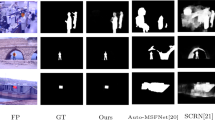Abstract
The human vision observes an image by making a series of fixations. In fixation, our eyes continually tremble, which is called the microsaccades that may reflect an optimal sampling strategy and spatiotemporal characteristics. Although the decrease in microsaccade magnitude leads to visual fading in our brain that may provide a mechanism to shift fixation. This paper proposes an iterative framework for figure-ground segmentation by sampling-learning via simulating human vision. First, fixation-based sampling is utilized to get a few positive and negative samples. A pixels classifier based on the RGB color could be trained by ELM (extreme learning machine) algorithm, which not only extracts object regions, but also provides a reference boundary of objects. Then, the boundary of object region could be refined by minimizing graph cut. The region of refined object can be re-sampled to provide more accurate samples/pixels involved object and background for the next training. The iteration would convergence when the pixel classifier gets stable segmentation result continually. Based on the ELM algorithm, the proposed method run faster than state-of-the-art method, and can cope with the complexity and uncertainty of the scene. Experimental results demonstrate the learning-based method could reliably segment multiple-color objects from complex scenes.











Similar content being viewed by others
References
Bagon S, Boiman O, Irani M (2008) What is a good image segment? A unified approach to segment extraction. ECCV, Part IV, LNCS, vol 5305, pp 30–44
Boiman O, Irani M (2006) Similarity by composition. Neural Inform Process Syst 19:177–184
Borenstein E, Ullman S (2004) Learning to segment. ECCV, LNCS, vol. 3023, pp 315–328
Borenstein E, Ullman S (2008) Combined top-down/bottom-up segmentation. IEEE Trans Pattern Anal Mach Intell 12:2109–2125
Boykov Y, Veksler O, Zabih R (2001) Fast approximate energy minimization via graph cuts. IEEE Trans Pattern Anal Mach Intell 23(11):1222–1239
Cao FL, Lin SB, Xu ZB (2010) Approximation capability of interpolation neural networks. Neurocomputing 74(1–3):457–460
Chacko BP, Vimal Krishnan VR, Raju G, Anto PB (2011) Handwritten character recognition using wavelet energy and extreme learning machine. Int J Mach Learn Cyber. doi:10.1007/s13042-011-0049-5
Cheng HD, Jiang XH, Sun Y, Wang JL (2001) Color image segmentation: advances and prospects. Pattern Recognit 34:2259–2281
Dong G, Xie M (2005) Color clustering and learning for image segmentation based on neural networks. IEEE Trans Neural Netw 4:925–936
Feng GR, Huang G-B, Lin QP et al (2009) Error minimized extreme learning machine with hidden nodes and incremental learning. IEEE Trans Neural Netw 20(8):1352–1357
Huang G-B (2010) Extreme learning machines. http://www3.ntu.edu.sg/home/egbhuang/ELM_Codes.htm
Huang G-B, Zhu Q-Y, Siew C-K (2006) Extreme learning machine: theory and applications. Neurocomputing 70:489–501
Huang G-B, Ding XJ, Zhou HM (2010) Optimization method based extreme learning machine for classification. Neurocomputing 74(12):155–163
Huang G-B, Wang DH, Lan Y (2011) Extreme learning machines: a survey. Int J Mach Learn Cyber 2(2):107–122
Itti L, Koch C, Niebur E (1998) A model of saliency-based visual attention for rapid scene analysis. IEEE Trans Pattern Anal Mach Intell 11:1254–1259
Jorge OM, Xoana GT, Stephen LM et al (2008) Saccades and microsaccades during visual fixation, exploration, and search: foundations for a common saccadic generator. J Vis 14:1–18, 21
Juang CF, Sun WK, Chen GC (2009) Object detection by histogram-based fuzzy classifier with support vector learning. Neurocomputing 72:2464–2476
Kadir T, Brady M (2001) Saliency, scale and image description. IJCV 45(2):83–105
Levin A, Weiss Y (2009) Learning to combine bottom-up and top-down segmentation. Int J Comput Vis 81:105–118
Lezoray O, Elmoataz A, Cardot H et al (2000) Segmentation of color images from serous cytology for automated cell classification. Anal Quant Cytol Histol 22(4):311–322
Matrin R (2009) Microsaccades: small steps on a long way. Vis Res 20:2415–2441
Mishra AK, Aloimonos Y (2009) Active segmentation. Int J Human Robot 3:361–386
Paul LR (2009) A simple method for detecting salient regions. Pattern Recognit 42:2363–2371
Poon B, Ashraful Amin M, Yan H (2011) Performance evaluation and comparison of PCA based human face recognition methods for distorted images. Int J Mach Learn Cyber 2(4):245–259
Sun YR, Fisher R (2003) Object-based visual attention for computer vision. Artif Intell 1:77–123
Sun YR, Fisher R, Wang F, Gomes HM (2008) A computer vision model for visual-object-based attention and eye movements. Comput Vis Image Underst 112:126–142
Tang Y, Yan P-K, Yuan Y, Li X-L (2011) Single-image super-resolution via local learning. Int J Mach Learn Cyber 2(1):15–23
Vapnik V (1998) Statistical learning theory. Wiley, New York
Walther D, Koch C (2006) Modeling attention to salient proto-objects. Neural Netw 19:1395–1407
Wang XZ, Dong C-R (2009) Improving generalization of fuzzy if-then rules by maximizing fuzzy entropy. IEEE Trans Fuzzy Syst 17(3):556–567
Wang XZ, Chen A, Feng HM (2011a) Upper integral network with extreme learning mechanism. Neurocomputing 74(16):2520–2525
Wang XZ, Dong L-C, Yan J-H (2011) Maximum ambiguity based sample selection in fuzzy decision tree induction. IEEE Trans Knowl Data Eng. doi:10.1109/TKDE.2011.67
Wu J, Wang ST, Chung F-L (2011) Positive and negative fuzzy rule system, extreme learning machine and image classification. Int J Mach Learn Cyber. doi:10.1007/s13042-011-0024-1
Xu ZB, Cao FL (2004) The essential order of approximation for neural networks. Sci China (F) 47(1):97–112
Xu X, Liu W-Q, Venkatesh S (2011) An innovative face image enhancement based on principle component analysis. Int J Mach Learn Cyber. doi:10.1007/s13042-011-0060-x
Acknowledgments
This work was supported by the grant of the Second stage of Brain Korea 21, the Natural Science Foundation of Zhejiang Province of China (No. Y1091039 and No. Y2091057) and the Natural Science Foundation of China (No. 60842009).
Author information
Authors and Affiliations
Corresponding author
Rights and permissions
About this article
Cite this article
Pan, C., Park, D.S., Lu, H. et al. Color image segmentation by fixation-based active learning with ELM. Soft Comput 16, 1569–1584 (2012). https://doi.org/10.1007/s00500-012-0830-8
Published:
Issue Date:
DOI: https://doi.org/10.1007/s00500-012-0830-8




